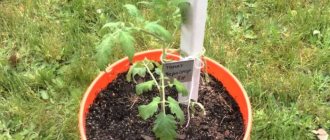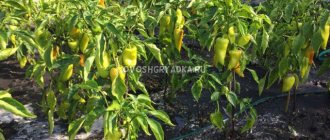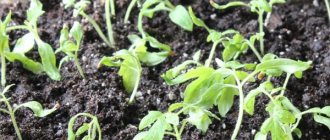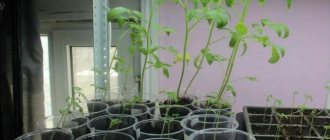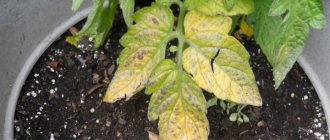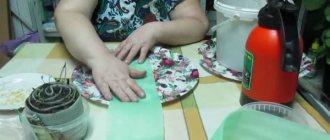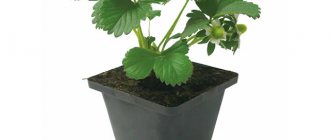Sometimes you may notice that tomato seedlings are overgrown. This problem is quite common and often worries gardeners.
At home, it occurs if:
- tomatoes do not receive enough light;
- too warm air in the room (more than +25 degrees);
- There is excess moisture in containers due to frequent and abundant watering.
You can understand which tomato seedlings are considered overgrown by the following signs:
- Slightly overgrown tomato seedlings are about 30 cm high. They have 4 leaves and elongated internodes. Such plants are not afraid of replanting. They take root in the soil without any additional conditions.
- What does medium overgrown seedling look like? The stem can reach 45 cm. The plants have 6 leaves and buds begin to form. These tomatoes are difficult to take root, and a new ovary may not appear again.
- If the seedlings have bloomed and their height is about 50-60 cm, then they are considered very overgrown. These tomatoes are difficult to grow. They usually die after planting in the ground.
Tomato seedlings planted at different times
Reasons for overgrowing seedlings
Strictly speaking, outgrowing seedlings and stretching are not the same thing. In tomatoes, the stem lengthens, but this happens for various reasons, and the appearance is different:
- Elongated tomatoes have thin shoots and long internodes. There are few leaves, perhaps 4-5, but they are located far from each other.
- Overgrown with the usual color for the variety, but too tall. The internodes are close, but there are many of them. The thickness of the stem is normal, or slightly thinner than required.
Reasons for pulling tomatoes:
- the seedlings are located too closely, they do not have enough light, the shoot stretches upward;
- the same thing happens if the tomatoes are standing on the windowsill without, or with insufficient lighting intensity;
- excessive watering;
- excess nitrogen fertilizing;
- high temperature – 25° C or more;
- when the seeds just hatched, they were not transferred to a cool place;
- there is no difference between day and night temperatures.
Seedlings outgrow if the seeds are sown too early or spring comes late. It's normal, it just wasn't planted in time, and it's grown big.
Frail seedlings
1. We often sow tomato seeds thickly without thinking about the consequences. As a result, a “lawn” grows in the planting container. If you don’t pick early, the seedlings will grow sandwiched between their neighbors. They will not have enough space, food, or light. The weakest ones have to be dived deeper than usual.
2. Stretched seedlings are often due to lack of lighting . This problem is solved in different ways. For example, shelves are attached to the window, allowing you to use not only the window sill area. It is better to make them from transparent material (carbonate, cellular polycarbonate, etc.).
I did not immediately notice the appearance of loops and did not move the container with the sown seeds to a bright place. From such seedlings you can also grow good seedlings
Lamps designed for growing plants are also suitable.
A simple solution is reflective screens. For example, from foil or white glossy surfaces.
Seedlings on a glass loggia can be placed on a special plant rack or on the floor closer to the glass
3. My seedlings grow best on a fully glazed loggia facing southwest. I place the boxes with pots in which the seedlings grow in the most illuminated place. If there is not enough space, use foam blocks (or packaging from equipment) on the floor of the loggia closer to the double-glazed window. Freshly picked tomato seedlings must be shaded. At least in the first days.
4. A warm habitat is necessary for seedlings only at the very first time. After picking, heat prevents the growth of strong seedlings . She feels better at 20 - 21°C during the day and 17 - 18°C at night. Then it is advisable to reduce the daytime temperature a little more.
5. A lot depends on watering . They shouldn't get carried away. Seedlings cannot grow in a “swamp”. It’s bad when periods of drought and waterlogging alternate. And they happen if you water rarely and abundantly. For the first three weeks I water the seedlings with a spoon.
Myths about overgrown seedlings
First of all, gardeners who are faced with overgrown seedlings should be reassured. It takes root no worse than the usual one, and produces a good harvest. But only if measures are taken in time and planted correctly.
Otherwise, overgrown tomato seedlings:
- will lie on the ground;
- may break;
- will experience nutritional deficiencies.
As a result, it grows weak and may actually die. You can’t plant bushes as they are.
There is no classification of elongated tomato seedlings by size. No one has done any research on when rooting ability changes. Moreover, there are varieties whose adult bushes grow up to 30 cm, or reach 2 m.
Nevertheless, articles devoted to the problem are replete with assurances:
- slightly overgrown tomatoes have a height of 30 cm and take root well;
- with an average degree (45 cm), it takes root poorly, the brush may extend before transplanting, and will not bloom again;
- at a strong stage of overgrowth - 60 cm, usually does not take root.
Even the smallest tomatoes can bloom if the seedlings are overdried, but not to such an extent that they die. And all the tomatoes will produce a harvest. It’s just that the first, largest and best brush will be lost. Flowers that appear before planting should be removed as soon as possible.
Regarding the catastrophically poor survival rate of seedlings above 60 cm. I would really like to advise ignorant authors of articles to take a ride in the spring on electric trains, minibuses or regular buses going in the direction of their summer cottages. And try to explain why some gardeners bring seedlings that are not just overgrown, but sometimes reach a meter long - the tops stick out from standard jute bags (96 cm). Moreover, it does not seem that they are particularly worried, or are going to ceremoniously bury the tomatoes in the open air.
A little less common is the puzzling statement that when tomatoes are buried, leaves and ovaries fall off. This is exactly the crop for which deep planting is recommended, even for regular-sized seedlings - adventitious roots quickly form on the stem. This is what gardeners have been doing for generations, and they get an excellent harvest. The bushes grow powerful, require less watering and suffer from temperature changes, and better withstand the wind in open ground. And no one has ever had anything fall off from a deep planting. Maybe we need to look for another reason?
Reviews from gardeners
Those who used Maslov's method when planting overgrown tomato seedlings claim that the most difficult thing to overcome is the psychological barrier a week after planting, when the seedlings begin to wither.
But, after about a week, after this, the seedlings begin to take on a fresh look, new leaves appear. As a rule, plants under such extreme conditions undergo a hardening stage, and subsequently produce a fairly good harvest even on soils with insufficient nutrients.
In this way, it is even possible to obtain an earlier harvest than when planting overgrown seedlings in another way. According to gardeners, the positive side of this method of planting is that it can minimize and facilitate the labor of growing plants.
What to do with overgrown tomatoes
Tomato seedlings need to be monitored. The first signs of overgrowth are clearly visible - the shoot stretches out. If you take action right away, you can slow down the process and obtain high-quality planting material.
Growth regulators
Gardeners are divided on growth regulators. Those who grow tomato seedlings for sale must use them. With minimal flaws in care, it is guaranteed not to stretch, the stems will be thick and strong.
Others use medications as desired. You just need to carefully read the instructions and strictly follow them. And choose retardants. Otherwise, instead of the expected containment, rapid growth of the aerial part, premature formation of ovaries, or some other effect can be caused.
There are many drugs. You can use the old, well-known Tour, or newer retardants:
- drug Atlet;
- Stocky;
- Antevylegach;
- Support;
- SSS.
They must be used very carefully, avoiding overdose, and only as a last resort. These drugs are classified as pesticides, and are not so harmless.
Care instructions
To prevent seedlings from stretching, you must strictly follow the growing rules. But if the tomatoes have already outgrown, you should:
- Increase lighting. Even on a southern windowsill, tomatoes lack it - sun activity and day length in early spring are insufficient even in regions with a hot climate. It is better to use a phytolamp for illumination; if you don’t have one, use a regular one, placing it not on the side, but above the plants. Tomatoes should have 15-16 hours during the day, the remaining 8-9 hours at night. Illumination in pieces, when it is convenient for the owners, is unacceptable.
- Carry out timely picking in the phase of 2-3 true leaves. If you delay the deadlines so that it is more convenient for inexperienced gardeners to carry out the operation, the tomatoes will definitely outgrow.
- Place bushes further away. When they are arranged in a cluster, the stem reaches towards the light, and the internodes lengthen.
- Reduce watering. But be very careful, since short drying of the substrate causes not only a suspension of growth processes, but also the formation of brushes. It is not recommended to plant tomatoes during flowering - the ovaries will have to be cut off as early as possible.
- Lower the temperature. It is easier for gardeners growing tomatoes in greenhouses with a controlled climate - they can transfer the seedlings there and freely arrange them on the ground. The rest should ventilate the room more often, open the window slightly, protecting the tomatoes with newspaper. At night they can be moved to the coolest place and placed on the floor - cold air accumulates there.
If the reason for the tomatoes to stretch is due to excess nitrogen fertilizers, nitrates can be blocked with unscheduled fast-acting phosphorus-potassium fertilizing. For example, potassium monophosphate.
Agent that inhibits the growth of seedlings
Among growth regulators that inhibit the growth of seedlings and improve their quality, the inexpensive “ Athlete ” (“Green Gardener’s Pharmacy”) is suitable. Today this is one of the most popular drugs (in ampoules). Reviews for it are contradictory.
1. Everyone notes a peculiar smell (manure, rotting fish).
2. When foliar treatment is carried out using a sprayer, sunburn may occur. Therefore, it is better to spray at night.
3. The opinion of most people: it is worth using “Athlete” in case of emergency. Some gardeners did not notice any special effect when using this product.
Here is a useful recommendation from a gardener living in the north. Every year his seedlings grow long due to lack of light. Treatment with "Athlete" is carried out twice (with an interval of 10 - 15 days) at the root. It is not done on the leaves due to the appearance of spots similar to burns. After the drug wears off, the seedlings grow with double strength. Watering (water) treated seedlings in the first 5 days significantly reduces the effectiveness of Atlet. Result: the seedlings look good, the root system is excellent, and the yield is high. Advice: use “Athlet” only if you water it twice at the root (30 - 50 ml each), starting from the appearance of the fourth true leaf.
Hardening
Actually, all tomato seedlings need to be hardened off, and not just the ones that are stretched out or overgrown. Otherwise, in open ground it will most likely die before it has time to take root. When planting in a greenhouse, it will hurt for a long time, it will take a lot of time to recover, and part of the crop will not have time to ripen.
7-10 days before moving to a permanent place, the tomatoes are taken outside, where they should spend about 2 hours. Plants protect from sun and wind.
Every day, the time spent in the fresh air of tomatoes is increased first by 1.5 hours, then the difference is increased to 3. On the last night, the seedlings should spend the night outside.
If the tomatoes are in a greenhouse, there is no need to take them out. You can simply open doors and windows for a while.
Seedlings that have wilted are planted
The simplest method is to lay the seedlings along the beds and sprinkle the root system with soil. This is the case if the tomato seedlings have wilted a little and can be laid without damage. A tomato in this position quickly takes root, new roots appear, that is, the number of bushes increases, and accordingly the harvest will be larger.
But before planting in this way, it is necessary to prepare the soil and the seedling itself. To do this, you need to remove the lower leaves. Make a hole in the garden bed and draw a furrow from it no more than 5 centimeters deep.
This method is ideal when the seedlings are sluggish and the stem is pliable and cannot break. The root is placed in the hole and the plant stem is placed along the groove. The root and that part of the stem that does not have leaves are sprinkled with earth and watered with water with a growth stimulator.
In this case, bird droppings, yeast, and manure will help, from which you need to make a special shake. It's easy and won't take much time. Cooking tips are available in our other articles. You should not try to plant seedlings that have not wilted in this way. So you can just break it. It’s better not to water the plant for a couple of days so that it becomes just that pliable.
Correct replanting in the ground
Tomatoes are planted so that only the first true leaf remains on the surface of the soil. The cotyledons are removed. But many gardeners try to deepen the seedlings as much as possible. This is justified, but it is important not to overdo it. You need to leave at least 2 leaves on the surface until the first flower cluster, where it forms - depends on the variety.
What to do with stretched seedlings? It is necessary to determine at what depth it will be planted, and, at least 24 hours in advance, cut off all the lower leaves so that they do not begin to rot in the ground. The wound surface will heal and infection will not penetrate into it. Planting methods may differ slightly, but, in essence, they come down to two main ones.
When placing overgrown seedlings in holes, it is not recommended to add nitrogen-containing fertilizers. If there are not enough nitrates in the future, they can be added to the root.
Landing lying down
If the seedlings are moderately overgrown:
- Dig an elongated, inclined hole the size of the stem freed from leaves, plus the root system.
- Fill with water.
- When the liquid is absorbed, put the tomato in it. The root should be located in the low part, the top should be on a hill.
- Carefully cover the stem with substrate.
- Lightly squeeze the ground.
- Water generously.
- Mulch with dry soil.
Humus cannot be used - it contains nitrogen. Soon the tomato will straighten up on its own, tall varieties can be tied up.
Spiral landing
If the seedlings are very elongated, it is recommended not to use the previous method. Not because the tomato will not grow well, but in order to save space and reduce labor costs.
Seedlings are planted in a spiral:
- Dig a deep, wide hole.
- Fill with water.
- A lump of earth braided with roots is placed in the center.
- The stem is carefully wrapped in a wide spiral. This does not mean that you need to make a spring out of a shoot. Usually half a turn is enough.
- Gently sprinkle with soil and squeeze.
- Water and mulch with dry substrate.
The seedlings are stretched
When growing at home, tomato seedlings often have to be limited in growth. Variety plays a big role. There are varieties that are difficult to spoil. The situation is worse with tall tomatoes.
1. I do not use any drugs intended to inhibit the growth of seedlings. I can carefully pinch off the cotyledon leaves and cut off (leaving a short “tail”) a couple of lower leaves . The seedlings react to this by temporarily inhibiting growth. Its stem is strengthening.
The “tails” remaining from the cotyledon leaves quickly dry out and fall off. This technique is absolutely safe and does not harm the seedlings.
Transshipment into new containers of larger volume also helps . It is transshipment (while maintaining the integrity of the earthen coma, penetrated by roots), and not transplantation.
3. You should not get carried away with nitrogen-containing fertilizers . Especially when the seeds were sown early. Stimulating the rapid development of green mass is fraught with difficulties when growing seedlings not in industrial greenhouses, but at home. Phosphorus and potassium do not accelerate the growth of seedlings, but make them powerful . I feed my tomatoes with superphosphate or wood ash the old fashioned way.
So, seedlings are affected by good lighting (at least 12 hours, but not around the clock), low air temperature with day and night differences, moderate watering and minimal use of nitrogen in fertilizing.
Weak seedlings exposed to a bright loggia have become stronger
If planted early
Tomato seedlings are pruned when they are very overgrown, and there is still a lot of time before they are planted in the ground or greenhouse. This usually happens due to late spring or early sowing of seeds.
To decide how to trim shoots, you need to consider:
- Removing half the stem is used if planting will be done in the near future. Otherwise, the tomatoes may stretch out again.
- When one bottom leaf is left, a stepson quickly forms from its axil. Subsequently, this will be the main escape.
- It is best to leave the bottom 2 sheets. Two stepsons will form, the growth point can be switched to the strongest one, and the other one can be broken off. When they leave one leaf, there is no choice; you have to be content with what grows.
Cut tomato stems can be shortened and the tops placed in water. They will quickly take root. The shoots are planted in individual cups and grown like ordinary seedlings. Their productivity and development will be no different from tomatoes grown from seeds.
Tomato seedlings should not be allowed to overgrow - it is difficult and time-consuming to plant, and you may lose the first cluster of fruit. But if this happens, there is no need to create a tragedy. There are many ways to correct the situation.
What to do if the tomatoes have already stretched out
There is no need to throw out overgrown seedlings; they can still be saved with the help of ready-made herbal remedies and folk recipes.
- Ready-made products. Retardants are used to slow down stem growth. The drug "Athlet" stops the growth of the stem, but stimulates its expansion. The seedling stops stretching, and the root system strengthens. “Athlete” is produced in the form of ampoules, which last for a week. After 6-7 days, the tomato grows again, and you can use another ampoule. It is dissolved in 300 ml of water and sprayed on the plant along the leaf and stem.
- Folk remedies. If you don’t want to use chemicals, you can use traditional methods. For tomatoes, digging up the stem helps. The plant is moved into a deep container, burying the root deeper. New roots quickly appear from it in the place where it is buried.
- Non-standard way. The trunk is cut where 2-3 leaves are located. The cut part is placed in water. After a few days, the roots sprout and the new seedling is transferred to a pot with soil. On the other cut part, stepsons grow - branches, which are also placed in water, and then they are buried in the ground. Stepchildren are planted so that their lower curved part is covered with soil.
- In situations where seedlings become very elongated and lose their rich green color, other methods of control are used. The paleness of the plant is a sign of nitrogen deficiency. With the correct dosage, problems with rapid growth are avoided. Mix a full spoonful of urea in ten liters of water. Water the tomato with this solution. After the manipulations, transfer the pot to a cool room with a temperature of up to 8 °C. If everything is done according to the instructions, the plant returns its rich emerald color and even stops growing intensively for some time.
- A stretched and fallen plant is a sign of disease. Blackleg attacks tomatoes, causing them to wilt. In this case, the seedlings are thrown away, and the ground is treated with Fitosporin, a solution of potassium permanganate or another fungicide. But it is better if a different soil is used for other seedlings, this is the most effective method.
Attention!
Blackleg is an infection that affects seedlings of densely planted tomatoes. It should be disposed of quickly so that the remaining seedlings do not become infected.
Tomato seedlings have outgrown: what to do
First of all, you need to choose the right place to place the seedlings; it should be sufficiently lit, without drafts. Thus, a north-facing window may provide less natural light than required. If you do not provide illumination with a lamp, the bush will overgrow.
Preparing for sowing
You need to start preparing by choosing a variety, based on the growing conditions: greenhouse or soil, northern region or southern region. Next you need to calculate the sowing date. The average period during which tomatoes are at home on the windowsill is two months. The norm for transferring to the garden bed is by the end of spring or beginning of summer. Such a calculation of the moment of sowing will help to achieve the required plant strength by the time when the tomato can be planted in the ground. However, it should not outgrow. The properties of varieties are taken into account:
- tall varieties are sown in early March; -sowing of greenhouse varieties is carried out in early February, in April the sprouts are transferred to the greenhouse; -in mid-March, early ripening fruits (such as cherry tomatoes) begin to grow.
Seedling
Attention! If you sow tomatoes early, the seedlings may become elongated and also wilt. It would not be surprising if such a tomato disappears after transplantation.
Kazarin's dry method
The author of the method is A.A. Kazarin figured out how to plant overgrown tomato seedlings, using the protective powers of the plant itself. This is real shock therapy, which consists of creating extreme conditions, namely deprivation of watering. It forces tomatoes to search for water on their own, growing a strong root system. Here are tips on how to plant overgrown tomato seedlings using the dry method:
- Make furrows about ten centimeters deep at a distance of 0.5 meters from each other;
- Pour 5 liters of compost, 250 ml of ash and one gram of potassium permanganate into each furrow;
- Water each furrow with five liters of water;
- Divide the stem into two parts and remove all leaves from the lower half of the bush. Immerse half the stem without leaves in a clay mash, then dust with dry soil.
- Lay the bush horizontally along the furrow and dig it into the ground to a depth of 5 centimeters. There is no need to increase the digging depth, because at greater depths there are no microorganisms that feed the plants;
- Pour another five liters of water over the surface of the soil onto each bush, being careful not to get it on the leaves.
- Do not lift the top yet, over time it will take a vertical position on its own, and only after that it is tied up;
- Then watering is stopped completely. You can resume watering while the fruits are ripening, but this will have a bad effect on the taste.
Attention!
Gardeners should exercise restraint and refrain from watering, even when the leaves begin to fade. This occurs during increased root growth. Literally after two weeks the leaves level out and the plant takes on a lush, beautiful shape. If the tomatoes are planted in open ground, then watering with rain will suffice, but this method is also recommended in greenhouses. With this rather “cruel” method, foliar and root feeding should not be neglected.
Not every gardener will decide to use this method, but for the sake of experimentation, you can sacrifice a couple of bushes to make sure that it works. This method manages to save even the most frail, overgrown seedlings.
Methods for planting elongated tomatoes in open ground
Even following the rules for sowing seedlings does not always help against overgrowth. Therefore, whenever possible, tomatoes are planted in open ground in such optimal ways.
Kazarin's dry method
The essence of this method is to create extreme conditions for tomatoes by limiting their watering. The tomato is planted in the ground, but no water is given. The roots begin to grow in search of moisture. By the time the fruits are ripe, tomatoes have formed an extensive root system.
- dig holes up to 10 cm deep;
- pour half a bucket of compost into the hole and mix with a glass of ash and 1 gram. potassium permanganate;
- pour half a bucket of water;
- tomato seedlings are divided and leaves are removed from the bottom;
- the stem is placed in the hole and covered with soil;
- pour another half bucket of water on top;
- if the top lies on the ground, it is left there, then it strengthens and rises on its own;
- The tomatoes are not watered all summer.
After the fruits appear, you can water them, but the taste will suffer. It is difficult to resist watering the bush when it begins to fade. But after the roots strengthen, the tomato straightens out on its own.
You may be interested in:
Tomato “Pink Honey”: characteristics and description of the variety An excellent variety of tomatoes “Pink Honey”, which can be planted annually by collecting seeds, because it is not a hybrid….Read more…
Planting slightly elongated seedlings
Seedlings that are half a meter or a little more long are not planted deeply. Otherwise, energy is spent on root growth, and the ovaries and flowers die.
- make a hole with an additional recess the size of the glass;
- water and plant long stems without covering them, leave in this position for a couple of weeks;
- the tomato takes root, the hole is filled in;
- After planting, they drive a stick into the ground and tie a stem to it.
Planting heavily overgrown tomatoes
Stems that have grown a meter are not planted vertically in the ground.
- make a long furrow and water generously;
- Leaves are removed from the lower half of the stem;
- plant the plant in a lying position, deepening the stem so that the top remains 20-30 cm;
- the stems are secured with staples;
- cover with earth, leave a hole, water again;
- The top of the seedling is secured vertically with a peg.
Attention!
After watering, the plant is mulched to retain moisture and provide oxygen to the soil.
Overgrown seedlings are not yet a reason to quit and throw away the stems. First, they understand the reasons and eliminate the problems. After this, they try to slow down the overgrowth. If it is not possible to slow down, methods of planting these plants are used. The main thing is not to panic, but to use consistent instructions to get tasty and healthy tomatoes.
Why are seedlings overgrown?
Let’s say it’s a very dark spring outside, the sun doesn’t look through the clouds at all, there’s not enough light, your additional lighting is not enough. Sometimes it happens that there is not enough power. You start watering, the plant seems to be growing, but in reality it is stretching, it lacks nutrients. Therefore, such seedlings are not isolated. I'm not the only one who grew up like this. Very often you can see how you go to the country and carry huge boxes at height, and your seedlings are still sticking out above the edges of this box.
What can I do to ensure that the plant takes root well?
Our cuttings are drying out, which means what infections do not occur during planting. We dig an elongated hole for such a plant, and we plant the plant, putting in almost all of this bare part.
We made such a hole. It's even slightly tilted. Then fill it with just water. You can add a tablet of gliocladin, or a couple of tablets. You can dilute these tablets in water and water them with this water, but it’s better to just throw them in there like this. When watered, they dissolve well. This is how we fill almost holes. You can add 3-5 liters of water.
Here there are already accessory roots, such irregularities, little white dots, tubercles. These are adventitious roots. Due to these adventitious roots of our own, which are sometimes visible, sometimes not visible (no problem, don’t worry, they will grow), we plant a clod of earth in this way, lying down.
You can deepen it further, if not deeply. And little by little we sprinkle it. Hold the top of your head, you can move the soil a little. And sprinkle it, compact it slightly with your hand. Here we make sure that our plant is in such a vertical position.
You can add a piece of earth. It will all level out. Don't even worry about it being slightly tilted. Seeing such good lighting, new nutritional elements, it will, of course, stretch upward, it will develop organically, there will no longer be such light thin leaves, such frail stems. We will have a wonderful plant growing. After such a good watering, we, of course, sprinkle it.
You know that the roots have gone, they are here somewhere. The next plant, if it is the same, again dig a long hole.
The next landing method. We dig a deep enough hole, you can even dig up more than half a shovel. You can even sprinkle a little fertilizer here. Again, let's throw in a couple of tablets of gliocladin, because I want to make sure that the plant does not get sick with any major fungal and bacterial diseases.
This is how we fill it. We take the next plant. It is still advisable to prepare the plants a few days in advance and trim these leaves 3-4, maybe even 5 days in advance.
Look how the plant is not well developed. The internodes are very large, the leaves are so light, completely stunted, the stem is dead. It's a pity for the plants. Of course, if we plant it straight away like this, tie it to ropes or some posts, it will still stretch. And it is difficult for him to draw a lot of juice through such a thin stalk in order to give a good harvest. We will plant this plant now, wrapping the stem in a ring. It's okay, don't worry. Tomatoes, unlike other even nightshade crops, are not afraid of unnecessary transplantation.
Here we make a hole, place the root system in this hole, bend the plant a little along with a lump of earth, twist it in this way and sprinkle it. See how well it's positioned here. Sprinkle it and squeeze the stem properly. The plant simply transformed, no longer looking like itself.
